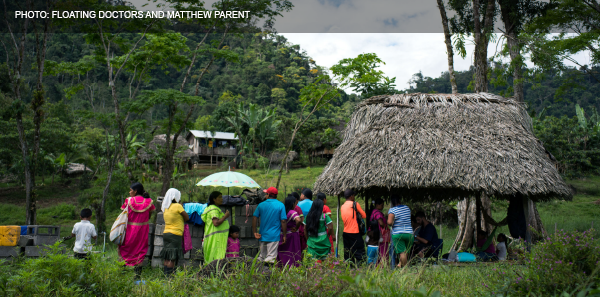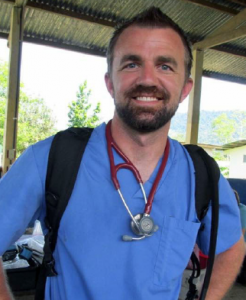
There are many volunteer programs that bring physicians from industrialized nations to developing or underserved areas to provide periodic medical care or care in times of crisis. However, not many are designed to provide ongoing care to communities in need—and that’s where Floating Doctors comes in. Through health professional volunteers, Floating Doctors provides ongoing primary health care services to communities in Panama while working with community members to improve health education and help reduce burdens on local health systems.
Explore This Issue
ACEP Now: Vol 36 – No 09 – September 2017
Floating Doctors has partnered with Clean the World to promote the use of soap, resulting in a huge decrease in scabies in the communities it serves.
PHOTO: Floating Doctors and Jonas Neichin
Recently, two physicians from Floating Doctors—Benjamin LaBrot, MD, and Ryan McCormick, MBBS, BAO—sat down with ACEP Now Medical Editor in Chief Kevin Klauer, DO, EJD, FACEP, to discuss the genesis and ongoing mission of the Floating Doctors program. Dr. LaBrot is the founder of Floating Doctors and the medical director and co-founder of RemoteCare Education, a tropical medicine competence and medical mission performance CME program held at Floating Doctors’ mission headquarters. Dr. McCormick is vice president of Floating Doctors and CEO of RemoteCare Education. Here are some highlights from their discussion.
KK: Where did Floating Doctors come from conceptually, and how did it get started?
BL: Floating Doctors is a nonprofit medical team providing primary health care, emergency care, and community development assistance to remote rural populations. The idea came from an impromptu accidental clinic that I ended up conducting while I was traveling in Tanzania in 2006.
I attended the Royal College of Surgeons in Ireland. One of my classmates suggested that I visit Tanzania. On my way out to the Serengeti, the guy driving suggested that we stop in a small Maasai village to see it, and I said, “Sure, that sounds very interesting.” When we got to the village and they found out that I was a doctor they said, “Oh, you’re a doctor! Do you mind having a look at this thing on my arm?” Ironically, the very first time that happened to me as a qualified doctor was in a tiny Maasai village in the middle of nowhere in East Africa. I saw one person, and then I saw another, and then I saw another, and pretty soon I ran out of everything I had with me in my own medical kit. I was like, “Oh, resource-limited health care.” Fifty or 60 patients and seven hours later, I finished up and got back into the car and had a moment of clarity. I’m going to come back to this village or any of the hundreds of thousands of communities just like this, but I’m going to bring a much bigger backpack. Floating Doctors is really a much bigger backpack with way more effective tools. The epilogue is that eight years later on my honeymoon, my wife and I went back to that village, and it was actually the highlight of our entire honeymoon, especially because they said, “What? You came back?” No doctor had visited since.
KK: How many communities are you serving at this point?
BL: At the moment, there’s a network of about 27 communities in western Panama that we visit every three months in rotation. In total, it’s probably closer to 35 or 40 communities. Some of the communities that we’ve chosen are strategically located so that when we’re there, people from neighboring communities can have access, too.
KK: Ryan, what are some of the things Floating Doctors is doing that are most impactful for these patients?

Dr. Ryan McCormick.
PHOTO: Ryan McCormick
RM: Well, one of the best parts of Floating Doctors is that, as opposed to other organizations, we don’t just go in for short-term fixes. We focus on making sustainable changes to the communities, providing not just health care but also a lot of education. We don’t just work in our clinics; we actually live beside a lot of these people. We live in the village for three or four days. We get to know them, and it’s through those personal relationships that we’re actually able to make the type of change that you can see as the months and the years go by.
KK: This sounds like third-world population health.
BL: Yeah. It could be functionally the same as an indigent population in Los Angeles. It really has a lot of the very same challenges. The most terrifying thing that our patients can hear is, “Hi, I’m from the government, and I’m here to help you.” Outside groups of any kind are something that the indigenous people in Panama have not had the greatest luck with since Columbus’s first voyage.
There were a lot of communities when we first went there that believed what we were doing was incomprehensible. It did not compute that we did not have some other kind of agenda. The assumption was that we must be spies for a hydroelectric or a mining concern or that we were working with the government against them in some way. Often, it would be one particular patient in which we’ve invested a huge amount of time and resources that would really let the community know, “Man, they’re really serious.”
KK: Is this one way that your organization is different than others?

Dr. Benjamin LaBrot in a boat running from a storm, en route to see patients.
PHOTO: Matt Dayka/Vitamin Angels
BL: Doctors Without Borders’ greatest strength is that they are able to deploy very large and efficient resources in a very short time. When the cholera epidemic came to Haiti, two days later they’re on the ground with cholera treatments and tents and camps all set up, but doing essentially ongoing primary care is much more unusual. A lot of what we do is geared toward trying to reduce the burden on the local health service, not just treating disease and the illnesses of our patients. We have data for about 40,000 patients in our database. We’re able to target the microclimates of health, and better yet, we’re then able to say this is an intervention that would work in this context of this health landscape.
KK: How many clinicians, physicians, nurses, physician assistants, etc. are actually working with you?
BL: Last year, we had something like 550 or 600 volunteers pass through from nine countries. People from 16 different countries have come to work with us.
KK: If ACEP members or others want to get involved, how would they do it?
BL: On our website’s volunteer page [FloatingDoctors.com], there’s some info about volunteering and also the application. They can email us and contact us if they have questions before they choose to apply. I would say another thing that really sets us apart is that one of my volunteers a couple of years ago said, “You know, [for other organizations] it’s much harder to volunteer than you would think. There’s a minimum requirement of two years, or it costs $2,000 for 10 days of a boondoggle where you do half a day of clinical work or you get there and the standard of care is poor.” How difficult volunteering for some organizations may be hadn’t really occurred to me, and one of the things that’s hard for US doctors is getting even one week off. We accept volunteers for shorter amounts of time. It’s a little bit different for ER doctors because ER doctors can actually take more than one week off.
KK: Are there suggestions that you offer to defray some of the costs so it’s not an obstacle or barrier to participating?
BL: For our volunteer fees? I guess if people can come longer. From our point of view, it’s much more desirable if people can come longer, and we do the weekly volunteer contribution, which we really use to run our entire program. That rate drops for each week that people can stay longer.
KK: So when they’re going to participate, they’re helping fund the mission and they’re also going to participate by donating their time. Is that how it works?
BL: Correct. I teach a course at the University of Southern California in their global health department, and one of the lesser-known tenants of mission work is that mission work needs to give benefit both to the recipients of care and also the participants.
KK: What’s the minimum amount of time that you would expect someone to put in, and what would be the contribution you would expect?
BL: The minimum that we really require is one week, but we sometimes will take people for one day. In general, our volunteers seem to indicate that three weeks is a really good minimum time. The one-week rate is $700, and that includes accommodation and meals. Ryan, what is it for two weeks?
RM: I want to say it’s either $600 or $650.
KK: With charging that amount for a week and providing food and accommodations, there’s clearly no room for profit. What percentage do you think goes to funding the mission beyond making sure that you’re housing and feeding the volunteers?
BL: That’s a good question. When we broke it down from our taxes last year, I think 6 percent went to administrative costs, and then pretty much everything else drove the clinical program itself.
KK: I think it’s important for people to hear that because there may be some degree of skepticism.
BL: Oh, yeah, I can’t stand when I get dozens and dozens of high-gloss, laminated mailings from organizations. Come on, this looks like it costs $10,000 to actually develop.
KK: The altruistic reasons that your organization exists are the same reasons why you probably are limited on how well you can get your message out. You’re not going to spend those dollars because those dollars come from the mission and your patients.
BL: Yeah. Literally every time you have to spend money on something that’s not actually related to driving the delivery of care, it hurts. All you can think of is the patients that we have on our advanced follow-up list who need open heart surgery and so many other services. Ryan, did you want to highlight the particular value of ER doctors in this kind of mission?
RM: They’re the jack-of-all-trades and the master of when everything falls apart.
KK: If you had a dream for how this story would end for Floating Doctors, what would be your hope for this program?
RM: That it wouldn’t end.
BL: Or I guess that it would end only when it was no longer needed.
KK: It’s really amazing that the two of you have done that, and I’m really honored to call you my colleagues.





No Responses to “Floating Doctors Volunteers Bring Patient Care to Remote Communities in Panama”